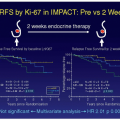The foremost trial comparing ALND with no axillary surgery is NSABP B-04 (
13) (
Table 38-1), as described above. Among patients randomized to total mastectomy alone, 18% developed axillary LR as the first sign of treatment failure and required a delayed ALND; 79% of axillary LR occurred within 2 years and 95% within 5 years. Two more recent trials demonstrate far lower rates of axillary LR in older patients treated without ALND. Martelli et al. (
18) randomized 219 patients (aged 65 to 80) with T1N0 disease to breast-conservation surgery with or without ALND, and all patients received 5 years of tamoxifen. At 5 years’ follow-up there were no differences in disease-free or overall survival, and axillary LR in the no-ALND arm was 1%. Rudenstam et al. (
19) randomized 473 patients (aged 60 years or more) to breast surgery with or without ALND; all patients received 5 years of tamoxifen. At 6.6 years’ follow-up there were no differences in disease-free or overall survival, and axillary LR in the ALND and no-ALND arms was 1% and 3%, respectively.
The addition of axillary RT improves local control in patients treated without axillary surgery (
Table 38-1). In NSABP B-04 (
13), locoregional recurrence at 10 years was lower with total mastectomy/RT than with total mastectomy alone (5% vs. 31%), as was axillary LR (3% vs. 19%). In the Cancer Research Campaign (King’s/Cambridge) trial (
20), 2,268 patients were randomized to total mastectomy/RT (to chest wall and axillary nodes) versus total mastectomy alone; again, crude LR was lower in the RT group (5% vs. 15%), as was axillary LR (2% vs. 13%). In a randomized trial from the Institut Curie, the authors compared the results of ALND and axillary RT in 658 patients; they observed a survival advantage for ALND at 5 years (
21), but no survival differences between groups at 10 and 15 years (
22). Axillary LR occurred slightly less often after ALND than after axillary RT (1% vs. 3%,
p = .04). Finally, Veronesi et al. (
23) randomized 435 patients, none of whom had ALND, to breast conservation with or without axillary RT. At 5 years’ follow-up they found no differences in disease-free survival, and axillary LR in the axillary RT and no-ALND arms was 0.5% and 1.5%, respectively. Three observational studies also report high rates of axillary LR in the untreated axilla and also show that axillary LR is highly dependent on tumor size (
Table 38-1) (
24,
25 and
26). Tumor characteristics alone, however, cannot reliably predict axillary node status with greater that 90% to 95% accuracy (
27). Bevilacqua et al. (
28) have recently developed a multivariate nomogram for the prediction of SLN metastases, using a sophisticated model based on 3,786 SLN biopsy procedures and prospectively validated in 1,545 subsequent procedures. They too find that the prediction of SLN status is imperfect, with only a 75% chance, between two randomly selected individuals (one of whom is node-positive), of correctly identifying the node-positive patient.
Others have asked whether noninvasive imaging can replace surgical staging. Neither CT nor MRI is adequate for lymph node staging. PET lacks the resolution to detect metastases smaller than 5 mm, so is subject to false-negative and false-positive results; in five reports, sensitivity ranges from 27% to 94%, and specificity from 43% to 97% (
29,
30,
31,
32 and
33). The results of axillary ultrasound (US) with fine-needle aspiration (FNA) vary widely, reflecting differences in methodology and case selection, but allow triage of FNA-positive patients directly to ALND (
34). US-guided FNA of axillary nodes can spare patients the added time and cost of SLN biopsy, but is insufficiently sensitive to replace surgical staging.







